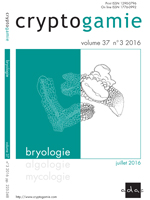We report on the phenology of the sporophytes of Octoblepharum albidum Hedw. (Calymperaceae), a moss growing in a seasonal ecosystem between the semi-deciduous Atlantic Forest and neotropical savanna areas of Brazil. We examined 100 sporophyte-bearing plants in ten different populations every two weeks between March/2014 and April/2015. This is the first analysis of phenological data of bryophytes using a circular presentation to interpret cyclical phenomena. Sporophyte development events in O. albidum were clearly seasonal, with the frequencies of all phenophases being related principally to rainfall. The three early stages of sporophyte development (immature to post-meiotic sporangium) occurred predominantly during the dry season, contrasting with sporangia dehiscence, which occurred mainly during the rainy season. Our findings contribute to a better understanding of the reproductive biology of bryophytes in tropical ecosystems, particularly those in seasonal habitats. We also highlight the consequences of misinterpreting some of the phenophases in mosses, and how revised concepts of these phases improved phenological interpretations.
How to translate text using browser tools
1 June 2016
How Tropical Moss Sporophytes Respond to Seasonality: Examples from a Semi-Deciduous Ecosystem in Brazil
Adaises S. Maciel-Silva ,
Mirian Pereira De Oliveira
ACCESS THE FULL ARTICLE
It is not available for individual sale.
This article is only available to subscribers.
It is not available for individual sale.
It is not available for individual sale.

Cryptogamie, Bryologie
Vol. 37 • No. 3
July 2016
Vol. 37 • No. 3
July 2016
Atlantic forest
bryophyte
Cerrado
Octoblepharum albidum
phenology




